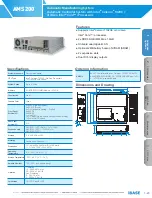
Lucent Technologies Lineage
®
2000 200A Ferroresonant Rectifier J85503B-2
8 - 2 Replacing Components and Circuit Modules
Issue 8 January 1999
•
The ac service and dc battery buses can be safely
disconnected from the rectifier by following the steps in
Section 7, “Disconnecting a Rectifier.” All work must be
done carefully because you are working with live cables at
battery bus potentials and current capabilities. The
disconnected charge battery and charge ground connectors
must be taped adequately to prevent them from contacting
each other or any other metal surface. Alternatively, the dc
battery cables from the rectifier can be disconnected at the
plant charge battery and charge ground buses.
•
Always make note of the lead connection points
(termination points) before unsoldering or disconnecting
them to insure trouble-free reinstallation. This includes
potentiometer leads, or the solderless, quick-disconnect type
connections used on circuit boards, relays, inductors,
transformers, and wire bundles.
•
Always disconnect quick-disconnect connections by pulling
straight apart with pliers to avoid bending or breaking the
tabs. Do not pull on wire. Always remember to save
hardware, thermal pads, and other items in a convenient
place for reassembly.
•
DC capacitors can be examined to see if they have “blown”
(i.e., vented) due to voltage breakdown failure. A small hole
in the capacitor top, called a “blowhole,” is plugged in a
new or good capacitor, but is empty (blown out) in a failed
unit. Some capacitor blowholes cannot be viewed directly
until removed or almost removed from the rectifier. A
dental-type mirror aids in viewing these capacitors'
blowholes before disassembly. Lucent recommends that all
dc capacitors in a rectifier be replaced whenever any one of
them blows.
•
Most component removals are straightforward and obvious.
Therefore, these procedures can be used as a guide by
qualified service personnel, rather than as step-by-step
procedures. For example, you may prefer to remove a part
not called for in order to make more room for access to a
component being replaced.
Tables 8-A and 8-B provide the reassembly torquing
requirements for the electrical and mechanical connections in
the rectifier. Torque values are given in inch-pounds or
foot-pounds and Newton-meters. Use these values unless
otherwise directed in the procedures.
















































